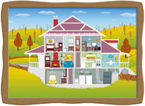http://www.cnn.com/2008/LIVING/wayoflife/02/29/redwoods.vs.solar.ap/index.html
Argument of the lesser of two...goods? Entertaining article about a dispute between two neighbors concerning redwoods infringing upon a neighbor's right to collect energy from his solar panels.
Argument of the lesser of two...goods? Entertaining article about a dispute between two neighbors concerning redwoods infringing upon a neighbor's right to collect energy from his solar panels.
My choice quotes:
"Treanor and Bissett, who drive a hybrid Toyota Prius, argue that trees absorb carbon dioxide, cool the surrounding air and provide a habitat for wildlife.
Vargas, who recently bought a plug-in electric car, counters it would take two or three acres of trees to reduce carbon dioxide emissions as much as the solar panels that cover his roof and backyard trellis."
